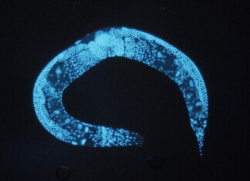This web page was produced as an assignment for Genetics 677, an undergraduate course at UW-Madison
Phenotypes
C. Elegans

Wormbase: The closest homolog to SMN1 that wormbase used for C.elegans was smn-1. A long list of associated phenotypes was listed. This list included shortened life span, locomotion abnormal, larval arrest, embryonic lethal, etc. Considering that this homolog likely plays a similar function in C.elegans, these results are not unexpected. Mutations in SMN1 that lead to spinal muscular atrophy result in many of the same phenotypes.
RNAi: Data for many of the described phenotypes was also confirmed with RNAi experiments. Wormbase presented the relevant experiments and the phenotypes that were observed. Most included lethality, slowed growth, shortened lifespan and a change in locomotion. Fewer than half of the phenotypes listed were unsupported by RNAi evidence.
D. Melanogaster

Flybase: There is only a single SMN gene in D.melanogaster as well (opposed to two in humans), so this homolog was used to compare phenotypes in D.melanogaster. Once again, the phenotypes are ones that I would expect, including: lethality, female sterility, cell death increase and neurophysiology defective. Thomas et al., 2007 noted that "SMN mutant animals show progressive loss of mobility and increasingly uncoordinated movement." This is identical to spinal muscular atrophy in homo sapiens.
Functions of the genes homologous to SMN1 result in phenotypes that we would expect. Several other phenotypes are realized that are the result of improper protein interactions that are necessary for RNA manipulation.
Analysis
Both Wormbase and Flybase the sites used were fairly straightforward. Wormbase was slightly more clear to me than Flybase. The information was easier to find, but this difference was very small. Both sites quickly provided me with the desired information as well as explanations and access to additional related information. Wormbase conveniently provided information about the RNAi experiments that supported the phenotypes that are cited while Flybase did not have this information.
I was unable to locate information about the specific phenotypes that occur in other organisms. Although, given the homology and expression of the tudor domain in homologs, I would expect the resulting phenotypes to be very similar.
1. Figure 1 Social Fiction (2006) Socialfiction zoo has a new specie. retrieved May 13, 2009 from: http://www.socialfiction.org/?n=313
2. Figure 2 Jean-Valéry Turatsinze(2008) Research Project Description retrieved May 13, 2009 from: http://www.bigre.ulb.ac.be/Users/jturatsi/research.html
William Baader
[email protected]
Mar 28 2009
www.gen677.weebly.com
